Written by Cathal McGrath.
115328516
This photo-essay will look at the theme of shopping in Dublin during the 19th and early 20th centuries. Most shops in Ireland were small family run businesses in the 19th century. Shopping was a very popular pastime at this time, especially amongst the female community. Shopping was seen as an activity for the wealthy upper class society so that they could flaunt there status and power over the middle class.
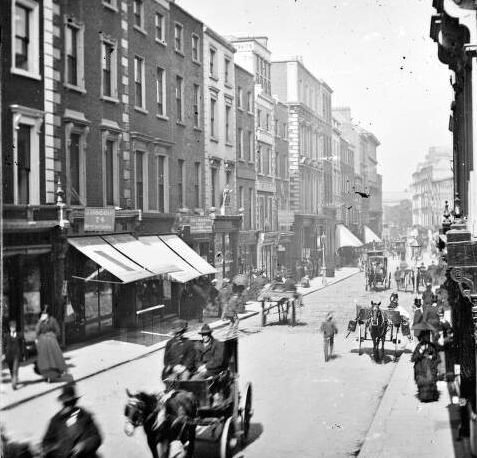
[Caption] Picture 1 : This image shows lots of people walking up and down Grafton Street shopping and others are showing there status on horse drawn carts (Source: National library of Ireland- the Stereo Pairs photograph collection).
Over the years in Dublin, shopping gained popularity and it became an extremely important experience in people’s everyday lives. This was the case for all classes within society. One street in particular flourished and thrived as a result of this growing popularity, Henry Street. People would shop on this street because it was a hub for different retail stores. “Whilst the clientele was undoubtedly from the privileged upper classes, there were a sizeable number of middle-class shoppers”, (18th-19th Century history, 2005). Large numbers of people could be sen on the street on a daily basis, those who could afford to purchase clothing could be seen carrying there shopping bags and those who couldn’t afford items could be seen window shopping at there dream clothing.
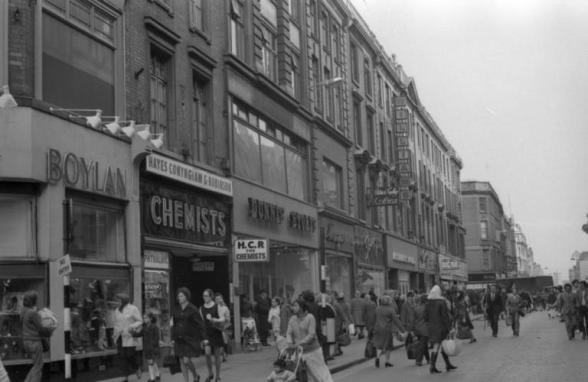
[Caption] Picture 2: This image shows shoppers wandering/strolling around Henry Street in 1971, many with bags and chatting with friends and families, using shopping as a form of a social activity, (Source: Dublin City council photographic collection).
From my research, I have discovered that many shops in Dublin were indeed boutiques, where both men and women would go to purchase fine well branded clothing. Ladies would go and find fantastically aesthetically pleasing dresses,accessories, etc. whilst the men would search for attractive three-piece suit. These boutiques provided people with a unique one on one customer service and they also provided the latest fashion trends for those who wished to keep up to date with style and in- fashion wear. Douglas Kellner says it best “Fashion and modernity go hand i hand to produce modern personalities” (Kellner.D, 1994).
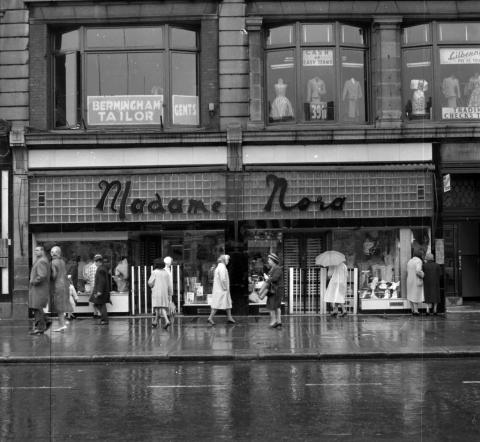
[Caption] Picture 3: This image captures well-dressed wealthy upper class men and women entering the boutique store Madame Nora, on O’Connell Street, Dublin in 1963, and there are also people window shopping ( Source: Dublin City council photographic collection).
At this time, shopping for groceries was an activity that all age groups could participate in and families wold often go shopping together. Men would rarely be seen shopping unless it was for there own clothing needs, women and children would do the grocery shopping on a daily basis.
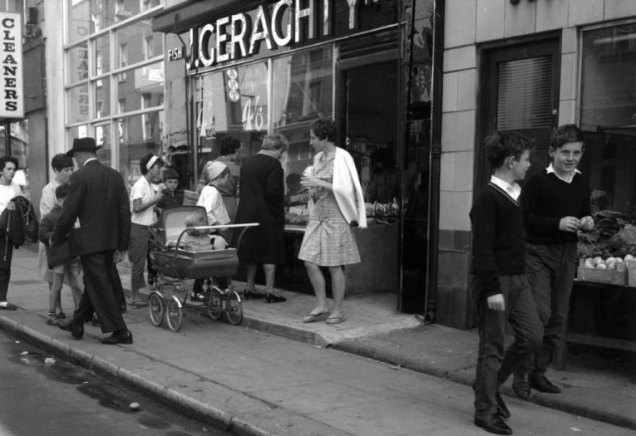
[Caption] Picture 4: This photo shows people of all ages outside the fish and poultry shop ‘Geraghtys’ on Marlborough Street in 1968, choosing which groceries to buy for the following day (Source: Dublin City council photographic collection).
The experience of shopping in the grocery shop differs from shopping in boutiques . The shelves within the grocery stores wold be packed with all the neccessary evryday goods/products, such as milk and bread. The grocery shop was a place to socialise and acted as a meeting place for people to share gossip. Families would still travel to the shop together, however they wold be dressed in a more casual nature, people werent worried about impessing other people with their fashion, it was a place of equality and friendlinesss.
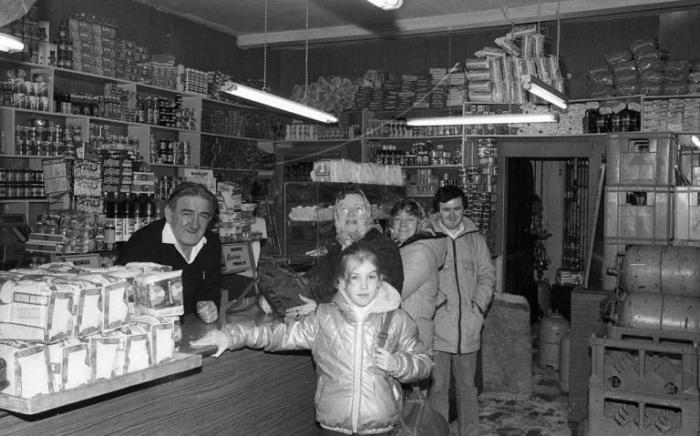
[Caption] Picture 5 (The Clincher): This photo epitomizes the warm, friendly atmosphere that was an ever present feeling within grocery shops. It shows different generations buying their groceries in Thomas McManus’ greengrocers on Railway Street in 1983, , (Source: Dublin City council photographic collection).
To conclude, shopping in Dublin in the 19th and early 20th centuries was an extremely important aspect of the everyday lives of men, women and children in the local community. Shopping played a significant role with social classes and within the Irish society at the time.
Picture sources:
- National Library of Ireland, The stereo pairs photograph collection, Lawrence Studios, Published between 1860-1883, accessed on the 25th of October, 2017, on http://catalogue.nli.ie/Search/Results?lookfor=&filter%5B%5D=collection%3A%22Stereo%20Pairs%20Collection%22&filter%5B%5D=format%3A%22Photo%22&filter%5B%5D=digitised%3A%22Digitised%22&view=grid
- Dublin City Council Photographic Collection, Dublin shops and shopping, Henry Street 1971, accessed on the 25th of October, 2017, on http://www.dublincity.ie/image/libraries/145-henry-street.
- Dublin City Council Photographic Collection, Dublin shops and shopping, Madame Nora- O’ Connell street 1963, accessed on the 26th of October, 2017, on http://www.dublincity.ie/image/libraries/193-madame-nora
- Dublin City Council Photographic Collection, Dublin shops and shopping, Geraghty’s Fish and Poultry Shop, Marlborough Street 1968, accessed on the 26thof October, 2017, on http://www.dublincity.ie/image/libraries/068-geraghtys.
- Dublin City Council Photographic Collection, Dublin shops and shopping, Interior of Thomas McManus, Greengrocer, The Shed, Railway Street 1983, accessed on the 25th of October 2017, on http://www.dublincity.ie/image/libraries/276-shed
Bibliography and References:
- (Spiller, K. and Linehan, D. (2006). ‘Beacons of modernity’: Department stores, modernity and the urban experience in mid‐twentieth century Ireland. Irish Geography, 39(2), pp.143-158).
- (Anon, (2017). [online] Available at: http://Irelands History Magazine, 18th-19th Century History, Frederick Vodreys ceramic designs for the 1880’s Dublin exhibitions, accessed on the 25th of October, 2017, [Accessed 31 Oct. 2017).
- (Antonio, R. and Kellner, D. (1992). Communication, Modernity, and Democracy in Habermas and Dewey. Symbolic Interaction, 15(3), pp.277-297).